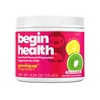Common Magnesium Myths Parents Should Know
share this article

Magnesium is an important mineral that supports your little one’s electrolyte balance, muscle function, and bone development (1). Although it plays a big role in many areas of the body, magnesium is often talked about in the content of adults.
Because of this, many parents aren’t sure how magnesium fits into their kid’s diet and whether their needs are different.
In this post, we’ll clear up the common misconceptions and myths about magnesium for kids so you can feel confident that they’re getting enough.
How Much & Sources
Before we dive into the myths, it helps to know how much magnesium your child needs and where they can get it from.
Daily magnesium intake varies by age (2):
-
0-6 months: 30mg
-
7-12 months: 75mg
-
1-3 years: 80mg
-
4-8 years: 130mg
-
9-13 years: 240mg
-
14-18 years (male): 410mg
-
14-18 years (female): 360mg
Top magnesium-rich foods include:
-
Spinach | 157mg per 1 cup cooked
-
Pumpkin Seeds | 156mg per 1 oz
-
Quinoa | 118mg per 1 cup cooked
-
Chia Seeds | 111mg per 1 oz
-
Brown Rice | 86mg per 1 cup cooked
-
Almonds | 77mg per 1 oz
-
Cashews | 74mg per 1 oz
-
Peanuts | 63mg per ¼ cup
-
Black Beans | 60mg per ½ cup
-
Avocado | 58mg per avocado
-
Peanut Butter | 50mg per 2 tablespoons
-
Plain Yogurt | 42mg per 8 oz
-
Banana | 32mg per banana
Myth #1 - "Magnesium Is Only a Problem for Adults”
It’s true that low magnesium is more common in adults. But kids also struggle to eat enough! Nearly 90% of teens between 14 and 18 fall short of their daily magnesium needs (3).
A big reason for this is the rise in processed food intake. Magnesium is found naturally in foods like leafy greens, beans, nuts, and seeds which aren’t always staples in a typical teen’s diet.
Myth #2 - "If My Kid Had Low Magnesium, It Would Be Obvious"
Low magnesium levels often show up as symptoms that are easy to overlook or blame on something else, like trouble sleeping, poor appetite, or low energy. These somewhat common issues can also have overlapping causes like growth spurts, stress, or changes in activity.
Plus, most magnesium in the body is stored in the bones and cells (rather than in the bloodstream). This means a blood test might not show low levels even if your child isn’t getting enough.
Myth #3: "Kids Get Plenty of Magnesium If They’re Not Picky Eaters”
Even if your little one eats a variety of foods and isn’t a picky eater, they could still be low in magnesium. A diet that’s higher in processed foods and lower in whole, nutrient-rich options can still miss key minerals.
If your child isn’t regularly eating foods like green vegetables, beans, nuts, seeds, or whole grains, they might be at risk for not getting enough magnesium.
Myth #4: "My Kids Get Enough Magnesium From a Multivitamin”
Many of the most common kid’s multivitamins do not contain magnesium. This is because magnesium can interfere with the absorption of other nutrients, so it’s often left out. If your kiddo needs magnesium support, a standard multivitamin probably isn’t enough!
Myth #5: "It Doesn’t Matter What Form of Magnesium Is Supplemented”
There are several forms of magnesium that each serve a different purpose for your little one. Magnesium citrate, glycinate, oxide, and malate all have unique benefits and absorb at different rates.
The best type for your child depends on their symptoms, digestion, and reason for taking magnesium.
Summary
Magnesium can play a big role in your kiddo’s health, but is often overlooked in kids’ nutrition. However, many kids might not be getting enough, symptoms can be difficult to spot, it can be tricky to get through kid-approved foods, and needs to be supplemented strategically.
















